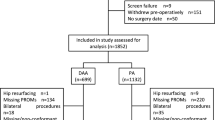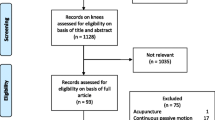Abstract
Background
Surgeons strive to set patient expectations for recovery following total hip arthroplasty (THA) and total knee arthroplasty (TKA). However, some patients report dissatisfaction after surgery due to unmet expectations.
Purpose
We compared patients’ and surgeon’s recovery expectations prior to primary THA and TKA.
Methods
Sixty eight patients scheduled to undergo primary total hip replacement (THR) or total knee replacement (TKR) surgery were enrolled. Before surgery, patients filled out a validated recovery expectations questionnaire that quantified expectations of postoperative pain relief, function, and well-being with a value from 0 to 100 (higher being more optimistic). The surgeon independently completed the same questionnaire for each patient. Overall score and item-specific comparisons were conducted. Correlations were explored between agreement level, demographics, patient-reported health status measures, and patients’ assessments of the risk of complications associated with surgery.
Results
Most patients undergoing THR or TKR had higher expectations for recovery than their surgeon. Applying the clinically meaningful difference in expectations (≥7 points), 52.5% of the TKA patients’ expectations exceeded those of the surgeon, while 22.5% expected less than their surgeon and 60.7% of THA patients’ expectations exceeded those of the surgeon, while 21.4% expected less than their surgeon. THA patients with either lower or higher expectations than their surgeon had lower physical and mental health status scores. TKA patients with lower expectations compared to their surgeon had a higher expectation of complications.
Conclusions
More than 50% of the patients had higher expectations than their surgeon and this was driven by expectations of high-level activities and extreme range of motion. Further investigations are needed to understand these differences so as to enhance patient preoperative education.
Similar content being viewed by others
References
Bellamy N. The WOMAC Knee and Hip Osteoarthritis Indices: development, validation, globalization and influence on the development of the AUSCAN Hand Osteoarthritis Indices. Clin Exp Rheumatol. 2005;23:S148-153.
Bellamy N, Buchanan WW, Goldsmith CH, Campbell J, Stitt LW. Validation study of WOMAC: a health status instrument for measuring clinically important patient relevant outcomes to antirheumatic drug therapy in patients with osteoarthritis of the hip or knee. J Rheumatol. 1988;15:1833–1840.
Bourne RB, Chesworth BM, Davis AM, Mahomed NN, Charron KD. Patient satisfaction after total knee arthroplasty: who is satisfied and who is not? Clin Orthop Relat Res. 2010;468:57–63.
Bozic KJ, Kurtz SM, Lau E, Ong K, Vail TP, Berry DJ. The epidemiology of revision total hip arthroplasty in the United States. J Bone Joint Surg Am. 2009;91:128–133.
Burns AC. The expanded health belief model as a basis for enlightened preventive health care practice and research. J Health Care Mark. 1992;12:32–45.
Groeneveld PW, Kwoh CK, Mor MK, Appelt CJ, Geng M, Gutierrez JC, Wessel DS, Ibrahim SA. Racial differences in expectations of joint replacement surgery outcomes. Arthritis Rheum. 2008;59:730–737.
Iversen MD, Daltroy LH, Fossel AH, Katz JN. The prognostic importance of patient pre-operative expectations of surgery for lumbar spinal stenosis. Patient Educ Couns. 1998;34:169–178.
Koch GG. Intraclass correlation coefficient. In: Johnson SKaNL, ed. Encyclopedia of Statistical Sciences. 4. New York: John Wiley & Sons; 1982:213–217.
Lingard EA, Sledge CB, Learmonth ID. Patient expectations regarding total knee arthroplasty: differences among the United States, United Kingdom, and Australia. J Bone Joint Surg Am. 2006;88:1201–1207.
Mahomed NN, Liang MH, Cook EF, Daltroy LH, Fortin PR, Fossel AH, Katz JN. The importance of patient expectations in predicting functional outcomes after total joint arthroplasty. J Rheumatol. 2002;29:1273–1279.
Mancuso CA, Graziano S, Briskie LM, Peterson MG, Pellicci PM, Salvati EA, Sculco TP. Randomized trials to modify patients' preoperative expectations of hip and knee arthroplasties. Clin Orthop Relat Res. 2008;466:424–431.
Mancuso CA, Sculco TP, Wickiewicz TL, Jones EC, Robbins L, Warren RF, Williams-Russo P. Patients' expectations of knee surgery. J Bone Joint Surg Am. 2001;83-A:1005–1012.
Memtsoudis SG, Gonzalez Della Valle A, Besculides MC, Gaber L, Sculco TP. In-hospital Complications and Mortality of Unilateral, Bilateral, and Revision TKA: Based on an estimate of 4,159,661 Discharges. Clin Orthop Relat Res. 2008;466:2617–2627.
Roos EM, Lohmander LS. The Knee injury and Osteoarthritis Outcome Score (KOOS): from joint injury to osteoarthritis. Health Qual Life Outcomes. 2003;1:64.
Roos EM, Toksvig-Larsen S. Knee injury and Osteoarthritis Outcome Score (KOOS)—validation and comparison to the WOMAC in total knee replacement. Health Qual Life Outcomes. 2003;1:17.
Saleh KJ, Mulhall KJ, Bershadsky B, Ghomrawi HM, White LE, Buyea CM, Krackow KA. Development and validation of a lower-extremity activity scale. Use for patients treated with revision total knee arthroplasty. J Bone Joint Surg Am. 2005;87:1985–1994.
Uhlmann RF, Inui TS, Carter WB. Patient requests and expectations. Definitions and clinical applications. Med Care. 1984;22:681–685.
Ware JE, Jr., Gandek B, Kosinski M, Aaronson NK, Apolone G, Brazier J, Bullinger M, Kaasa S, Leplege A, Prieto L, Sullivan M, Thunedborg K. The equivalence of SF-36 summary health scores estimated using standard and country-specific algorithms in 10 countries: results from the IQOLA Project. International Quality of Life Assessment. J Clin Epidemiol. 1998;51:1167–1170.
Ware JE, Jr., Sherbourne CD. The MOS 36-item short-form health survey (SF-36). I. Conceptual framework and item selection. Med Care. 1992;30:473–483.
Ware JE, Jr.; Kosinski, M.; Gandek, B. SF-36 Health Survey: Manual and Interpretation Guide. Lincoln, RI: Qualitymetric Incorporated,1993, 2000, 2005.
Wilson NA, Schneller ES, Montgomery K, Bozic KJ. Hip and knee implants: current trends and policy considerations. Health Aff (Millwood). 2008;27:1587–1598.
Author information
Authors and Affiliations
Corresponding author
Additional information
Each author certifies that he or she has no commercial associations (e.g., consultancies, stock ownership, equity interest, patent/licensing arrangements, etc.) that might pose a conflict of interest in connection with the submitted article. This research was supported by the generous donation of Mr. Salomon Melkman and by the Center for Education and Research on Therapeutics (CERTs; Agency of Health Research and Quality RFA-HS-05-14). Dr. Ghomrawi is supported in part by a career development grant from the Eunice Kennedy Shriver National Institute of Child Health & Human Development (K99 HD060686). The content is solely the responsibility of the authors and does not necessarily represent the official views of the Eunice Kennedy Shriver National Institute of Child Health & Human Development or the National Institutes of Health.
Each author certifies that his or her institution has approved the reporting of these cases, that all investigations were conducted in conformity with the ethical principles of research, and that informed consent for participating in the study was obtained.
Level of evidence: level 1, prognostic study
Rights and permissions
About this article
Cite this article
Ghomrawi, H.M.K., Franco Ferrando, N., Mandl, L.A. et al. How Often are Patient and Surgeon Recovery Expectations for Total Joint Arthroplasty Aligned? Results of a Pilot Study. HSS Jrnl 7, 229–234 (2011). https://doi.org/10.1007/s11420-011-9203-6
Received:
Accepted:
Published:
Issue Date:
DOI: https://doi.org/10.1007/s11420-011-9203-6




